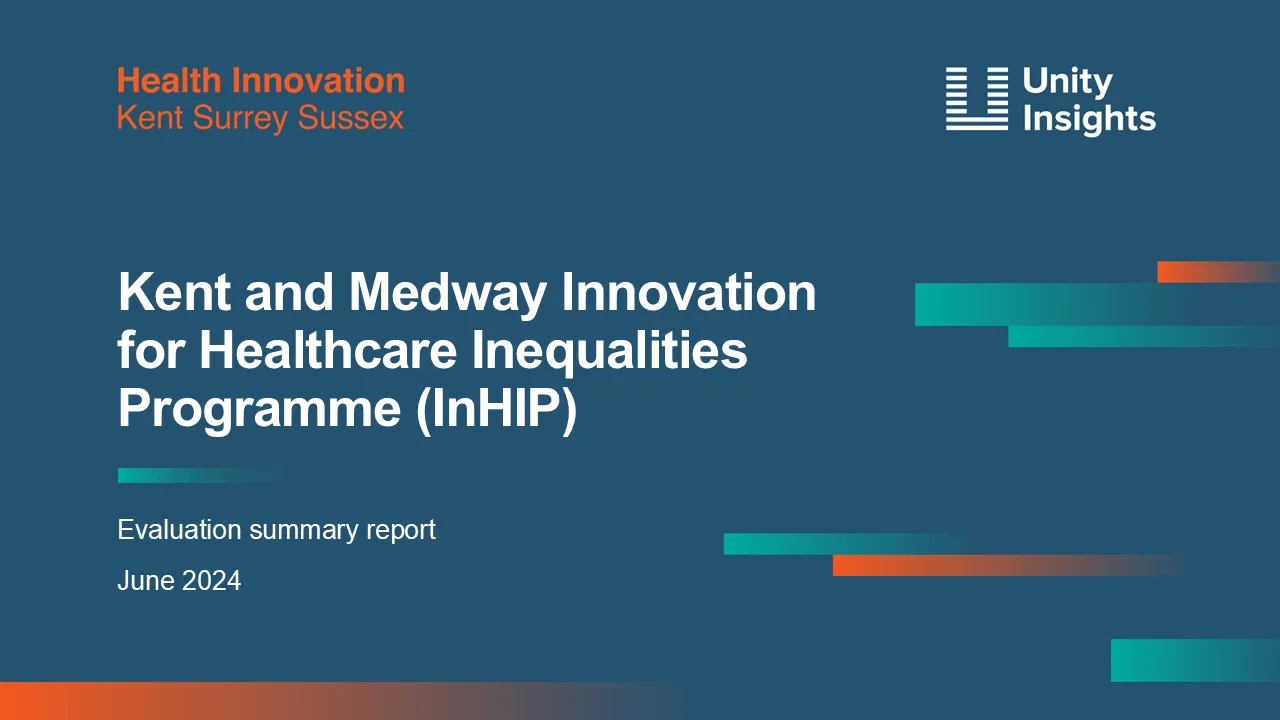Case Study, News
Kent and Medway Innovation for Healthcare Inequalities Programme (InHIP)
30 March 2024

Introduction
The Kent and Medway InHIP project’s primary aim was to improve access to care, detection and effective management of hypercholesterolemia to reduce risk of CVD morbidity and mortality, with particular focus on improving access to screening and treatment in the Lower Super Output Areas (LSOAs) who are amongst the 20% most deprived in England, females aged 40 to 59 years old and ethnic minority groups (including Traveller communities).
This was achieved through primary care case finding and treatment intervention through lipid lowering therapies and NICE-recommended therapies.
The aim of this evaluation was to support local quality improvement efforts, contribute to the national AAC evaluation workstream, and inform future projects addressing inequalities by sharing valuable insights and learnings.
The following questions were identified for the purposes of the evaluation
- How effective has the project been at reaching under-served groups (Core20PLUS)?
- What effect has the project had on outputs or outcomes across the target groups?
- What has been the monetary impact of the InHIP programme?
- Is the approach a feasible option for future initiatives?
Methodology
A mixed-methods evaluation was completed to evaluate the InHIP programme in Kent and Medway. This consisted of the below methodology:
Quantitative insights
The data received comprised 845 individuals. Of this, 205 received a medication intervention, where 11 were NICE-recommended therapies. Health metrics included: Patient cholesterol and whether they were at threshold, patient blood pressure and whether they were hypertensive, and medication intervention received.
Qualitative insights
Four interviews were conducted with key delivery members of the Kent and Medway InHIP project, lasting up to 45 minutes. Interviews were held over Microsoft Teams during January 2024 to February 2024. Participants were prompted on eight interview questions. Thematic analysis was conducted on the interview transcripts to organise the analysis by each theme. Staff surveys were also conducted, with responses analysed by the InHIP delivery team.
Benefit forecast modelling insights
The number of patients in the total population sample was multiplied by the proportion of patients treated to threshold, associated risk reductions in adverse events and their associated costs to estimate total five-year savings to the health and social care system.
Results
Access
- Core20 individuals comprised of 78% of the project sample.
- Mocketts Wood Surgery had the highest share, at 87%.
- Females ages 40 to 59 years old comprised of 20% of the project sample.
- The Limes Medical Centre had the highest share, at 29%.
- Ethnic minority groups comprised 2.5% of the project sample, compared to 4.8% of those with known CVD diagnoses in the wider ICB.
- Due to data limitations, the true share of ethnic minority groups in the project sample could reasonably be expected to be larger.
Impact
- 288* individuals were treated to threshold.
- 222 Core20 individuals (33.7% of group).
- 59 females ages 40-69 (34.7% of group).
- 9 individuals from ethnic minority groups (42.9% of group).
*Due to double counting among the Core20 and Ethnic minority groups, individual group values may not sum to 288.
- 557 individuals were not treated to threshold.
Five-year monetary benefits (2023/24 – 2027/28)
- £8,181 was forecasted to be saved in the project sample through escalation to lipid management.
- £154,274 was forecasted to be saved through escalation to lipid management in an ICB-wide rollout scenario.
Summary of findings
How effective has the project been at reaching under-served groups (Core20PLUS5)?
Every individual who was reviewed (n=845) and who benefited as part of the project were from Core20PLUS. Of these, 220 individuals attended and received a blood test appointment, and 24% (n=205) of the total sample received a medication intervention. Core20 individuals made up most of the sample (78%, n=659). While those from an ethnic minority group only made up 3% (n=21) of the sample, this is likely to be higher due to the way data was captured.
What effect has the project had on outputs or outcomes across the target groups?
As a result of the programme case finding, 557 individuals amongst the total project sample were identified as not treated to threshold and in need of intervention, and 205 of the total sample received a medication intervention within the study period. Ultimately, the project successfully reached 160 individuals from the pre-defined health inequality groups that were not to threshold and escalated them to appropriate lipid lowering therapy. Moreover, within the study period there was an increase of 143 individuals who were treated to target within the practices involved. If not for this project, these service users may have been delayed in being identified and receiving an appropriate intervention.
What has been the monetary impact of the InHIP programme?
The benefit forecast model indicates a potential £154k benefit to health and social care in the Kent and Medway ICB region over 5 years, reflecting measurable and monetisable project benefits. However, the project’s total impact is expected to surpass these figures. The combination of these monetisable benefits alongside anticipated non-monetisable gains underscores the business case for further project investment and scaling. It is important, though, to conduct a thorough cost review before proceeding with any expansion.
Is the approach a feasible option for future initiatives?
Interviews highlighted the support and challenges that the evolving InHIP project has faced, the importance of longer appointments and exploring different methods of communications to secure engagement and adherence to treatment. Despite this, concerns were raised on longer term sustainability, as the impacts on budgets and the complexities of reducing health inequalities across the system are apparent with wider system pressures and changes ongoing.